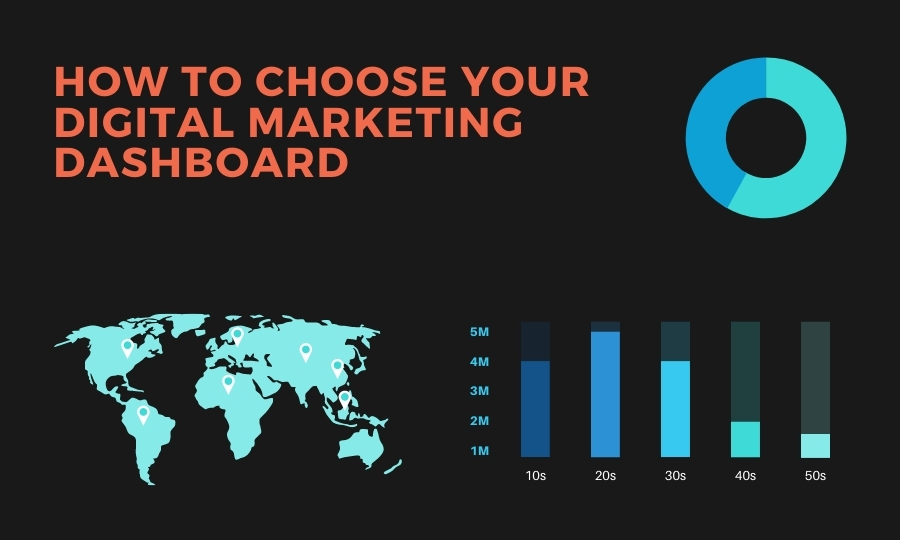Choosing a digital marketing dashboard can be difficult. This post helps to make the process of selecting a dashboard easier and more effective. Let’s start by defining what as dashboard is.
What is a digital marketing dashboard?
A digital marketing dashboard is a collection of metrics, with the purpose of displaying important information in regards to your business. Typically using visualizations to make the data easier to digest.
And just like a dashboard in your car, a digital marketing dashboard is there to provide you with a top-level overview of your key data points, with the ability to dive deeper into the data, to provide data and insights.
Often you can filter the data by different variables to zoom in on details. And export the data, do combine with other sources, or to create reports from.
Read more:
What is a marketing dashboard used for?
A marketing dashboard is used to keep an eye on the performance of marketing initiatives. The visualization and fast processing of large amounts of data, enables marketers to get a big picture view of what is happening. And yet they can also zoom in on particular dimensions to get the granularity of what is going on.
In effect the dashboard is a reflection of the performance happening out in the market. This data-led feedback loop, gives marketers the information to make informed decisions. It can provide early signs of success (or failure), identify areas of improvement and help demonstrate the ROI of efforts.
These digital analytics can help establish digital KPIs for the team. Often users will check their analytics each day, pinning the tab in their browser. Or reviewing on a regular basis.
Related reading:
Different types of digital marketing dashboards
There are many digital marketing analytics dashboards out there. They typically unify tracking and reporting, to save your team valuable time and resources that could be better spent elsewhere.
When evaluating what dashboard you need, try to think about it through this lens: what marketing activities are you consistently doing? And what platforms are most capable of empowering you in your efforts?
Here are some of the different types of dashboards.
1) Web analytics dashboards
Traditional page analytics tools, such as Google Analytics and Adobe, are great for analyzing websites. Digital analytics tools like Nudge modernize these solutions for the modern web.
Read more:
2) Content measurement dashboards
Content measurement & analytics dashboards enable marketers to track, report, and improve on the performance of their content marketing campaigns against the set goals. Compared to web analytics, these dashboards include metrics that are more content-centric, and therefore, so are the insights.
Our own platform, Nudge is a leading actor in this category; we show the impact of content by giving marketers a holistic view of clicks, content, and sentiment.
What an analytics dashboard looks like:

Read more:
3) Search & SEO dashboards
These dashboards provide prompt insights into what’s currently going on with your or your competitor’s website from a search engine point of view. They can bridge search marketing and SEO. From keyword research to on-page SEO analysis. SEMrush, Ahrefs, and Moz are all commonly used platforms by marketers in this category.
4) Paid advertising dashboards
These are typically included wherever you buy your ads, but there are also purpose-built platforms that let you view your paid media activity across sources to analyze KPIs like spend, impressions, clicks, and conversions in one place. Alight Analytics’s marketing intelligence platform ChannelMix, is an example of this.
5) Social media dashboards
These are reporting tools used to measure engagement metrics across multiple social platforms. They typically pull data from Facebook, Twitter, LinkedIn, Instagram, and Pinterest to create unified metrics reports, so you can understand what’s working where. They often include the ability to schedule and post to each social network too, and sometimes cover more specialized tools such as social listening. HootSuite, HubSpot, and Sprout Social are all examples of these dashboards.
6) Email marketing dashboards
These highlight key metrics that demonstrate the ROI and performance of your marketing email campaigns. They enable marketers to determine what actually resonates with their target audience. You can usually create and send both single email send-outs or automated emails based on the targeting rules you’ve applied. MailChimp, CampaignMonitor, and ActiveCampaign are all examples of email marketing dashboards.
7) Ecommerce marketing dashboards
These give Ecommerce teams a central place to access data that has an impact on day-to-day activity, budgeting and decision making. DashThis and PenPath are both examples of platforms that do this.
The best digital marketing dashboard is the one you use
Think about what you need from a dashboard. Use that information as a checklist when evaluating the different platforms’ features and capabilities. By doing this, you’re more likely to make the right decision for your business straight away.
Items that might be on your dashboard checklist:
- Does the data, help inform success of our objectives?
- Is it updated frequently enough?
- Can I test the dashboard before making a commitment?
- How can I export data?
- What level of training is required to use this dashboard?
- Can juniors use this dashboard?
- How easy is it to create reports of the data shared?
- How often do they update the dashboard?
- What is the customer support like?
..

|
|---|



